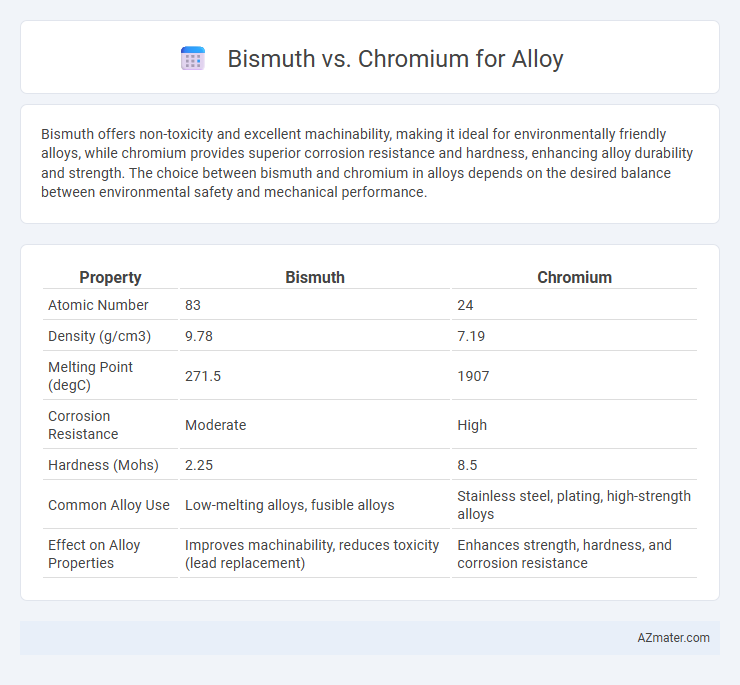Bismuth offers non-toxicity and excellent machinability, making it ideal for environmentally friendly alloys, while chromium provides superior corrosion resistance and hardness, enhancing alloy durability and strength. The choice between bismuth and chromium in alloys depends on the desired balance between environmental safety and mechanical performance.
Table of Comparison
| Property | Bismuth | Chromium |
|---|---|---|
| Atomic Number | 83 | 24 |
| Density (g/cm3) | 9.78 | 7.19 |
| Melting Point (degC) | 271.5 | 1907 |
| Corrosion Resistance | Moderate | High |
| Hardness (Mohs) | 2.25 | 8.5 |
| Common Alloy Use | Low-melting alloys, fusible alloys | Stainless steel, plating, high-strength alloys |
| Effect on Alloy Properties | Improves machinability, reduces toxicity (lead replacement) | Enhances strength, hardness, and corrosion resistance |
Introduction to Bismuth and Chromium Alloys
Bismuth alloys are prized for their low toxicity, excellent machinability, and unique expansion upon solidification, making them ideal for precision casting and environmental applications. Chromium alloys, known for exceptional hardness, corrosion resistance, and high-temperature stability, are widely used in stainless steel production and wear-resistant coatings. The distinct physical and chemical properties of bismuth and chromium alloys cater to specialized industrial needs, from non-toxic metal matrix composites to durable structural components.
Chemical Properties: Bismuth vs Chromium
Bismuth exhibits low toxicity, high density, and poor electrical conductivity, with notable diamagnetic behavior and resistance to oxidation at room temperature, making it useful for corrosion-resistant alloys. Chromium features high hardness, excellent corrosion resistance due to its ability to form a stable oxide layer, and significant electrical conductivity, contributing to the enhancement of stainless steel and wear-resistant alloys. In alloy formation, chromium improves mechanical strength and oxidation resistance, while bismuth imparts machinability and thermal stability, driven by their distinct chemical properties.
Physical Characteristics and Appearance
Bismuth in alloys typically imparts low melting points, high density (approximately 9.78 g/cm3), and a brittle yet crystalline structure, often resulting in a silvery-white, iridescent appearance. Chromium contributes to alloys with high hardness, excellent corrosion resistance, and a stable body-centered cubic structure, exhibiting a shiny, metallic-gray finish. The choice between bismuth and chromium in alloy formulations significantly impacts mechanical strength, thermal stability, and surface reflectivity.
Alloying Behavior and Compatibility
Bismuth exhibits low solubility in most metals and tends to segregate at grain boundaries, which can reduce ductility and weaken the alloy structure when combined with chromium. Chromium forms stable solid solutions with various metals due to its high melting point and strong affinity for elements like iron and nickel, enhancing corrosion resistance and mechanical strength in alloys. Alloying chromium with bismuth is generally challenging as their differing atomic sizes and bonding behaviors limit compatibility, often resulting in phase separation or brittle intermetallic compounds.
Mechanical Strength: A Comparative Analysis
Bismuth alloys exhibit lower mechanical strength compared to chromium-based alloys due to bismuth's inherent brittleness and lower tensile strength values, typically around 30-50 MPa. Chromium alloys, conversely, offer superior mechanical strength, with tensile strengths exceeding 500 MPa and enhanced hardness, making them ideal for applications requiring durability and wear resistance. The presence of chromium significantly improves the alloy's yield strength and fatigue resistance, whereas bismuth's inclusion primarily aids machinability but compromises structural integrity.
Corrosion Resistance in Alloys
Bismuth enhances corrosion resistance in alloys by providing a protective oxide layer, particularly in lead-free solders and low-melting alloys. Chromium significantly improves corrosion resistance through the formation of a stable and dense chromium oxide film, commonly utilized in stainless steels and high-performance alloys. Alloys with chromium exhibit superior durability and resistance to oxidation and chemical attack compared to bismuth-containing alloys.
Applications in Industry
Bismuth alloys excel in low-toxicity applications such as fire safety devices, where their non-toxic properties improve environmental compliance, while chromium alloys dominate in industries requiring exceptional hardness and corrosion resistance, including automotive and aerospace components. The integration of bismuth in fusible alloys enables precise thermal control in fire detectors and electrical fuses, contrasting with chromium's widespread use in stainless steels for manufacturing durable machinery and structural parts. Industrial specialization dictates choice: bismuth alloys contribute to eco-friendly, recyclable materials, whereas chromium alloys provide critical strength and longevity in demanding mechanical environments.
Environmental and Health Considerations
Bismuth is favored in alloys for its non-toxic and environmentally friendly properties, making it a safer alternative to chromium, which poses significant health risks including carcinogenicity and respiratory hazards. Chromium, especially hexavalent chromium used in plating and pigments, is regulated due to its potential to cause lung cancer and skin irritation. Incorporating bismuth reduces environmental contamination and occupational health concerns associated with chromium exposure in alloy manufacturing.
Cost and Availability Comparison
Bismuth is generally more expensive and less abundant than chromium, impacting overall alloy production costs significantly. Chromium's widespread availability and lower market price make it a more cost-effective choice for large-scale alloy manufacturing. The price volatility of bismuth due to limited mining sources contrasts sharply with chromium's stable supply chain driven by extensive global extraction.
Choosing the Right Alloying Element
Bismuth and chromium serve distinct roles in alloy production, with chromium primarily enhancing corrosion resistance and hardness, making it ideal for stainless steel and wear-resistant applications. Bismuth, a softer and more brittle element, is often chosen for its non-toxic properties and ability to improve machinability in alloys, especially in lead-free solders and free-machining steels. Selecting between bismuth and chromium hinges on the desired alloy characteristics, such as corrosion resistance, mechanical strength, and environmental considerations.

Infographic: Bismuth vs Chromium for Alloy
 azmater.com
azmater.com